The Power Of X
A simple yet powerful lighting technique anyone can master in under a minute.
Yes! Send Me My Free Video
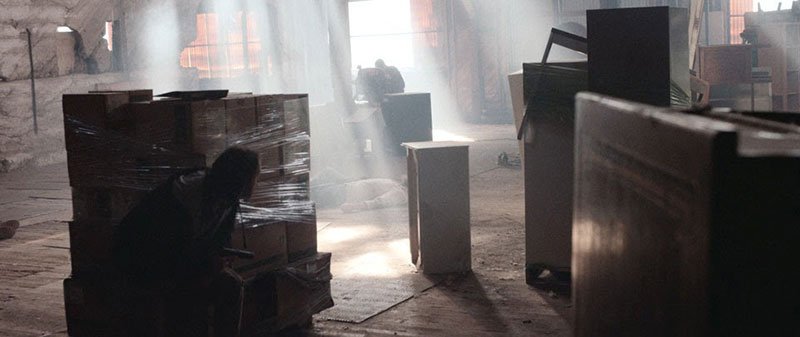
Filming an action film is a daunting task even under the best of circumstances. More overwhelming is when you only have three in your lighting crew and you’re cramming two days worth of set-ups into one day. That was what we had to pull off for the short film, “Easy Day” (2013) (video embedded below). In this post, I’m going to share how we did it, and then give you three lighting tips that will make your next action film look amazing.
“Easy Day”
Written & Directed by Shawn Nelson
As I have said countless times before — especially when pulling off high quality visuals with limited resources — the key to great lighting is preproduction, preproduction, preproduction. This is particularly true when shooting an action film.
Action films often involve locations with a lot of space. (Without space, it is difficult to create ballistic movement and nerve racking suspense.) So an action film with a limited budget, a small crew, and a tight schedule is very difficult to light because all that space needs to be lit. For this project the warehouse location measured 10,000 square feet. Lighting such a vast area normally means bringing in large lights – think 18k HMIs. But big lights also mean a large crew to manhandle them as well as a pre-light day to rig them. For this project, that was clearly not going to happen…
Since I couldn’t place artificial lights where I wanted the sun to be, I was forced to embrace what was there and plan accordingly. The first step of preproduction was scouting the location to see what it provided me, and observe how the sun moved and lit the space. This required my go-to sun app: SunSeeker.

SunSeeker App, iPhone Screen Capture
Fortunately for me, this warehouse stretched north/south, meaning the side windows faced east/west. These large windows meant the sun would pour in during the morning and afternoon, doing most of the heavy lifting of lighting the location. This left me only to point the camera in the correct direction for that time of day. The only time the location would not look great would be that small window of time around midday.
So the director Shawn Nelson and I came up with the following plan:

Looking East, Morning
We shoot looking east in the morning to take advantage of the sun, which would be our key light. (This lighting was very “side-y,” perfect for the look we were after.)
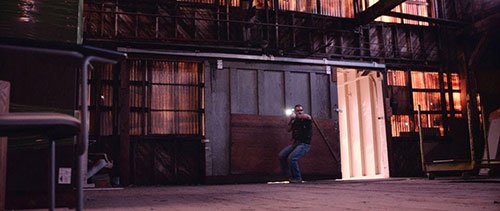
Looking South, Mid Day
At midday, we would turn south then schedule our lunch break to let the sun continue westward. (Only a couple shots looked good during the midday sun, since the sun only backlit some of the windows.)
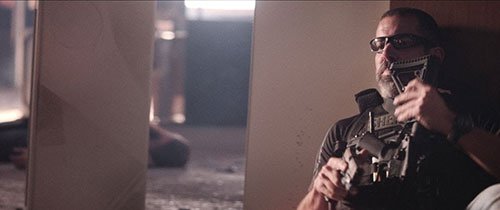
Looking West, Later In The Day
In the afternoon we faced west to again take advantage of the sunlight flowing through the windows.
While the sun did a lot of the work lighting the warehouse, we couldn’t just show up and shoot. To create the exact look we wanted, we still needed to supplement the light, add some accents, and then remove some light from certain areas.
This is where the real art of lighting comes in: knowing where to place accents and where to remove them; it is something I’m still working to master. For this particular film, I wanted to highlight the immense warehouse space. I focused on placing lights in the scene that showed off the depth of the location without drawing attention to itself.
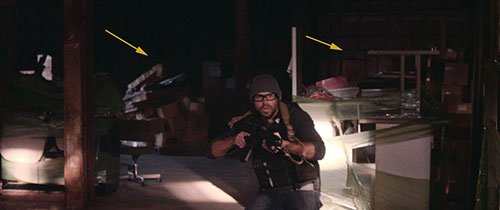
Background Lighting Accents
Having a small lighting package actually actually helped with this. Around 95% of the accent lights in the background are from the five 4′ MacTech LED tubes in our kit. Their decent CRI, daylight color temperature, high light output, and low power draw made them the perfect light to use. (Especially since we only had three 20 amp circuits to work with.)

More Background Lighting Accents
These background accents helped me add extra depth and texture to each shot. Without these lights, the background would have fallen off into black making the space feel smaller. If we had done this we may as well have been shooting in someone’s garage, since that is what it would have felt like.
|
Check out:
|
I would love to say it was my lighting design gave this film its amazing look, the truth is it wouldn’t have looked nearly as good if the location and props had not been carefully selected.
This is often where I see most indie films and small productions failing. Many times they don’t spend the time finding and dressing a location so that it fits the story. Even if I had a 20 person lighting crew, three days of pre-lighting, and a $15,000 lighting budget, if the location was a 20 foot by 20 foot white walled room and the props were plastic toy guns, it still would have looked like crap. And using the wrong location would have made my job MUCH TOUGHER! Instead of accenting the location and embracing the texture, I would have had to hide and minimize everything as much as possible.

Location & Props Make All The Difference
The texture of this location was amazing: the walls and floor were covered in paint, dirt, broken glass, and dust. Everything was naturally weathered and worn. We hung some Visqueen in the doorways, aging it with spray paint and dirty water to give it more texture. We had a briefcase of “coke,” and all of the guns were real (though outfitted with the proper blanks, and handled by trained professionals, of course). These little details added together create the magic that ended up on screen. The lighting just highlighted them so they could shine.
By finding the proper location, outfitting it with the right props and set dressing, then scheduling the day to take advantage of the light, we were able to maximize one day of shooting to get everything we needed for this film. While an additional day to shoot would have been even better, especially when we were pinched for time for the exterior car sequence, in the end it was about embracing what we had to work with and maximizing everything to the fullest.
The biggest time sucks on this project were the blood squibs. They ate up a lot more time than we had scheduled. Those delays made me concerned about fitting in the exterior car scene, as we were shooting it only with available light, and it was the last thing to shoot on our schedule.
So, after we got what we needed for the interior fight scene, Shawn and I talked and agreed to skip the groin squib shot, coming back to it only after we shot everything else. While the groin shot was “cool,” the exterior car scene was much more important since it introduced the film.

Pick-Up Shot, Squib Hit
Since this last squib shot was a close up, I knew I could come back after sunset and light it artificially to match everything else. When we returned to a completely dark warehouse to shoot our last shot of the day, it was an easy task to light and shoot this last scene.
Using a source four as the “sun light,” I had it positioned to rake across his leg like the sun had done earlier that day. Then I took a couple of MacTech tubes, bounced them into a 4′ x 6′ white Sun Bounce, which I raked across the background. And, viola! An insert shot that cuts perfectly with what we shot earlier that day.
(SIDE NOTE: This is where having a light meter and a good memory come in handy. I remembered what the scene felt like, and my meter allowed me to dial in the proper light levels to match what we already shot.)
[For those of you who remember the tutorial I did on building a wireless transmitter for $275, this is the project that we used it on- and it worked great. 🙂 ]
What tips do you have for shooting and lighting an action film on a tight budget and with a small crew?
Until Next Time – Get Out There And Shoot!
Ryan E. Walters, Cinematographer
 https://indiecinemaacademy.com/wp-content/uploads/2016/01/LC120-CorporateVideo-Thumbnail-Web.jpg
450
800
Ryan E. Walters
https://indiecinemaacademy.com/wp-content/uploads/2013/12/Indie_cinema_Logo_2color-MF-300x116-web.png
Ryan E. Walters2016-01-11 00:15:082016-05-05 11:22:30How to Cinematically Light a Corporate Video (Cinematic Lighting Lesson 20)
https://indiecinemaacademy.com/wp-content/uploads/2016/01/LC120-CorporateVideo-Thumbnail-Web.jpg
450
800
Ryan E. Walters
https://indiecinemaacademy.com/wp-content/uploads/2013/12/Indie_cinema_Logo_2color-MF-300x116-web.png
Ryan E. Walters2016-01-11 00:15:082016-05-05 11:22:30How to Cinematically Light a Corporate Video (Cinematic Lighting Lesson 20)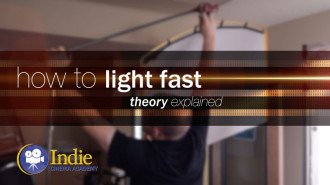 https://indiecinemaacademy.com/wp-content/uploads/2015/12/LC119-LightFast-Thumbnail.jpg
450
800
Ryan E. Walters
https://indiecinemaacademy.com/wp-content/uploads/2013/12/Indie_cinema_Logo_2color-MF-300x116-web.png
Ryan E. Walters2015-12-29 12:38:562016-01-10 21:42:39How To Light Quickly (Cinematic Lighting Lesson 19)
https://indiecinemaacademy.com/wp-content/uploads/2015/12/LC119-LightFast-Thumbnail.jpg
450
800
Ryan E. Walters
https://indiecinemaacademy.com/wp-content/uploads/2013/12/Indie_cinema_Logo_2color-MF-300x116-web.png
Ryan E. Walters2015-12-29 12:38:562016-01-10 21:42:39How To Light Quickly (Cinematic Lighting Lesson 19)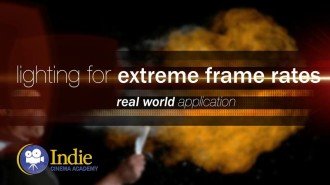 https://indiecinemaacademy.com/wp-content/uploads/2015/09/LC121_LightingHighSpeed-Thumbnail-Web.jpg
450
800
Ryan E. Walters
https://indiecinemaacademy.com/wp-content/uploads/2013/12/Indie_cinema_Logo_2color-MF-300x116-web.png
Ryan E. Walters2015-09-21 00:15:372016-01-10 21:42:57Lighting For Extreme Frame Rates (Cinematic Lighting Lesson 21)
https://indiecinemaacademy.com/wp-content/uploads/2015/09/LC121_LightingHighSpeed-Thumbnail-Web.jpg
450
800
Ryan E. Walters
https://indiecinemaacademy.com/wp-content/uploads/2013/12/Indie_cinema_Logo_2color-MF-300x116-web.png
Ryan E. Walters2015-09-21 00:15:372016-01-10 21:42:57Lighting For Extreme Frame Rates (Cinematic Lighting Lesson 21)You must be logged in to post a comment.
This site uses Akismet to reduce spam. Learn how your comment data is processed.
This site uses cookies. By continuing to browse the site, you are agreeing to our use of cookies.
AcceptHide notification onlySettingsWe may request cookies to be set on your device. We use cookies to let us know when you visit our websites, how you interact with us, to enrich your user experience, and to customize your relationship with our website.
Click on the different category headings to find out more. You can also change some of your preferences. Note that blocking some types of cookies may impact your experience on our websites and the services we are able to offer.
These cookies are strictly necessary to provide you with services available through our website and to use some of its features.
Because these cookies are strictly necessary to deliver the website, refusing them will have impact how our site functions. You always can block or delete cookies by changing your browser settings and force blocking all cookies on this website. But this will always prompt you to accept/refuse cookies when revisiting our site.
We fully respect if you want to refuse cookies but to avoid asking you again and again kindly allow us to store a cookie for that. You are free to opt out any time or opt in for other cookies to get a better experience. If you refuse cookies we will remove all set cookies in our domain.
We provide you with a list of stored cookies on your computer in our domain so you can check what we stored. Due to security reasons we are not able to show or modify cookies from other domains. You can check these in your browser security settings.
We also use different external services like Google Webfonts, Google Maps, and external Video providers. Since these providers may collect personal data like your IP address we allow you to block them here. Please be aware that this might heavily reduce the functionality and appearance of our site. Changes will take effect once you reload the page.
Google Webfont Settings:
Google Map Settings:
Google reCaptcha Settings:
Vimeo and Youtube video embeds:
You can read about our cookies and privacy settings in detail on our Privacy Policy Page.
Privacy Policy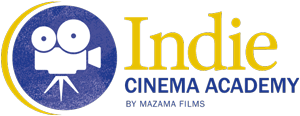
One of my cousins loves to create videos and he is the one that records our family events. I like how you said that an action film with a limited budget, a small crew, and a tight schedule is very difficult to light because all that space needs to be lit. I will recommend my cousin to look for software that can help him edit his videos since he wanted to create a new video with his friends playing paintball.
These days it is easier and easier to make your own action films. So much of the energy and drama of an action scene comes from the camera movement and fast edits, and less about the lighting and technology. (Same goes with the horror genre.) Just released yesterday, the co-director for “John Wick” (and director of a lot of big action films you’d recognize) made a snowball fight short for Apple that was filmed exclusively on Apple’s new iPhone 11 Pro. Yes, they had a full crew, lights, bounce, smoke, drone, stunt performers (to train the kids), etc. But notice how much of the video comes simply from the camera angles and the edits. Those often just take careful planning and execution, which are free.
Here’s the finished video:
And here’s the behind the scenes of how they did it:
Thanks for helping me understand that bright lights are needed for a large area or studio such as using 18k HMIs. I guess there are various movie production lights rental equipment services out there who can provide startups or even large companies to create the films they plan to record. With the right lighting, I guess the outcome of the scenes would be clear and attractive to future consumers who might watch them in the cinema.
Yes, often renting lights is the best way for startups. These days with brighter and brighter LED lights, there are more options than just large HMI lights.